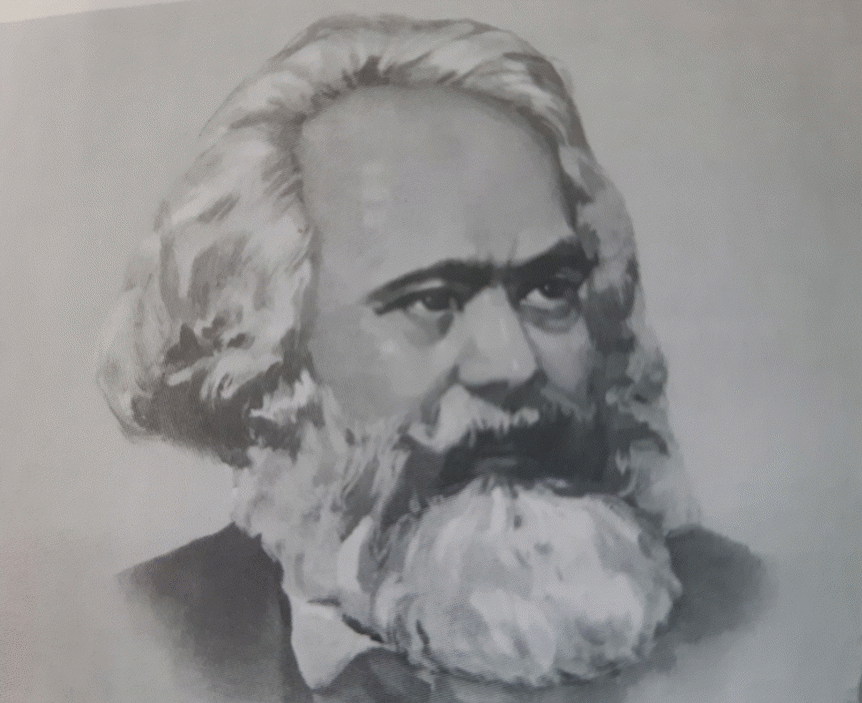By Michael Roberts
Recently, I made a short presentation to a discussion group of the Communist Party of India (M) youth on Marx’s reproduction schema. I thought the subject might also be worth a post on my blog.
Marx’s reproduction schema are to be found in Capital Volume Two Part 3 chapters 18 to 21. What are these reproduction schema? It is, as Marx put it, about: “the process of circulation (which in its entirety is a form of the process of reproduction) …. of aggregate social capital.” In other words, how capital (money and commodities) circulates at the macro level of an economy, in order to reproduce itself so that a new period of production and accumulation of capital can recommence.
Capital goods and consumer goods
Marx shows this process of circulation and reproduction by dividing aggregate social capital into two departments: one that reproduces capital goods or means of production and one that reproduces consumer goods or means of consumption. There could be more departments, but Marx’s division is not arbitrary because he wants to show the class nature of capitalist accumulation and reproduction; with one department that produces capital’s means of production and one that produces labour’s necessary consumer goods. The latter can be divided further into a ‘luxury goods’ department for capitalists’ own consumption, but this sub-department is not analytically essential in Marx’s reproduction schema (contrary to the views of many neo-Ricardians and some Marxists).
What does Marx want to show with the reproduction schema? He wants to show: first, how capital reproduces itself in these two departments; and second, he wants to compare the reproduction of capital without any extra accumulation (called simple reproduction) and the reproduction of capital when it accumulates (grows), which he calls expanded or extended reproduction.
The schemes assume that there is no technological progress, so growth (expanded reproduction) can occur only if a greater amount of means of production is obtained. Marx’s schemes also assume a closed economy. So additional means of production cannot be had from any reserves held in warehouses etc.
Simple reproduction
In simple reproduction, Department I (means of production) and Department II (means of consumption) grow at the same (zero) rate. Below is a table taken from the excellent paper on the schema by Andrew Kliman, drawing on the work of Dunayevskaya.

In this example of simple reproduction, both departments are the same size. But where does Department II (consumer goods) get its means of production in order to produce consumer goods equivalent to 500 in value? The consumer goods capitalists in Department II need 250c in value of means of production. The answer is that the consumer goods capitalists buy their 250c means of production from the capital goods capitalists in Department I. And that is possible because it is the amount of new value produced by the capital goods capitalists in Department I (v100+s150). Thus we have the formula for simple reproduction: c2 = v1+ s1. This shows how capital circulates between the two departments in a zero-growth economy.
Expanded reproduction
But what about a growing economy, what Marx called extended or expanded reproduction? Growth in a closed economy is only possible if extra value is added to investment in means of production. So Department I must be larger. That can happen if some of the newly produced means of production that Department II would have obtained are instead diverted to Department I. This gives Department I the additional means of production it needs.
In Kliman’s example, Department I gets an extra 50c in means of production and Department II’s investment in means of production is reduced by that amount. As a result, given the same ratios for c/v and s/v, production rises in Department I to 600 and falls in Department II to 400. See Year 2 below.

In the following Year 3, the 600 previously produced in means of production is distributed in the same ratio between Departments I and II as in Year 2. Now both departments have more invested in means of production and so both can grow (in total from 1000 in value in Year 2 to 1200 in Year 3.
Unbalanced growth in the different economic “departments”
The transition from simple to expanded reproduction requires unbalanced growth. Department I must grow relative to Department II. That does not mean that the consumer goods sector must decline absolutely, except maybe when ‘starting from scratch’ with zero growth. Subsequently, Department II can grow. Indeed, the two departments could then grow at the same rate, as they do in Marx’s own examples of expanded reproduction. But the relative imbalance will persist. Department I will remain relatively larger than Department II under expanded reproduction than under simple reproduction. Thus Marx’s schema show that the departments are never in ‘equilibrium’ if we mean by that that they are both the same size and must grow together at the same pace.
Different views after Marx
Marx developed the reproduction schema not to show that capitalism can accumulate harmoniously or in equilibrium. This idea was the view adopted by Marxists after Marx, such as Bauer and Kautsky, who took the reproduction schemas to show that undisturbed accumulation can take place under capitalism and crises could be avoided. Hilferding concluded that crises were due to disproportionalities between Departments 1 and 2 but these could be avoided by thorough planning: “in capitalist production both reproduction on a simple as well as on an extended scale can proceed undisturbed if only these proportions are maintained’. Then capitalism could grow without crises.
Rosa Luxemburg also misunderstood Marx’s schema but from the opposite view. She thought the imbalance between the size of Department I and Department II over time was the cause of crises because consumption would be insufficient to realise all the production of capital goods. She thought here was a chronic imbalance of investment over consumption that Marx did not recognise and this was key to crises.
But Marx’s reproduction schema were not designed to show that capital can either accumulate harmoniously, or alternatively generate chronic crises of under-consumption. Yes, capital does not accumulate in a harmonious way. As Marx says, “demand and supply never coincide or if they do, only by chance and thus not to be taken into account or for scientific purpose, it should be considered as not having happened.” That means that are “so many possibilities of crises, since a balance is itself an accident owing to the spontaneous nature of this production”. But if supply grows faster in Department I than in Department II, that does not imply a chronic, secular shortfall in effective demand, as Luxemburg thought. Investment demand can grow faster than consumer demand without crises.
Rising organic composition of capital
Marx’s simple reproduction requires a “balance” (an equality) between the new value generated in Department I (vI + sI) and Department II’s demand for constant capital (c2). But expanded reproduction requires that the new value generated in Department I exceeds Department II’s demand for constant capital. As Lenin put it: “Marx demonstrated clearly in his schemes, the production of the means of production can and must outstrip the production of articles of consumption.” Contrary to Luxemburg’s conclusion of crises flowing from the imbalance, Marx took the opposite view that the imbalance was necessary for growth, otherwise, “there would be no capitalist production at all if it had to develop simultaneously and evenly in all spheres.”
Indeed, an expanding capitalist economy with a larger Department I than Department II expresses the general law of capitalist accumulation, namely a faster rise in constant capital over variable capital, or a rising organic composition of capital. “Accumulate, accumulate! That is Moses and the prophets! … Accumulation for the sake of accumulation, production for the sake of production: this was the formula in which classical economics expressed the historical mission of the bourgeoisie in the period of its domination. Thus the capitalist economy increasingly becomes a system of production for production’s sake.” As Marx says: “It will never do, therefore, to represent capitalist production as something which it is not, namely as production having for its immediate purpose the consumption of goods or the production of means of enjoyment, for capitalists. This would be overlooking the specific character of capitalist production.”
Actually, Luxemburg herself saw the relation between the imbalance in the reproduction schema and the rising organic composition of capital and thus Marx’s law of profitability: “The quicker growth of Department I as against Department II is beyond dispute …. It is the foundation also of Marx’s fundamental law that the rate of profit tends to fall.” Exactly! But she failed to recognise was that this meant the cause of crises lay in the profitability of capital, not in the imbalance between the departments of reproduction of capital. The reproduction schema abstract from the cause of crises as such, which, in Marx’s theory, is to be found in the factors driving falling profitability, namely labour-saving technological changes and the concomitant increases in productivity.
The nature of economic growth
Indeed, when you think about it, the reproduction schema show the very nature of economic growth namely, using more of the value produced in the previous period to invest in extra means of production and labour to increase total value in the new period. That’s the logic of the schema and empirically it’s the reality. Kliman provides evidence that in the US, investment demand was 72 times as large as in 1933, while GDP was only 18 times as large and personal consumption demand was only 15 times as large (see graph below).
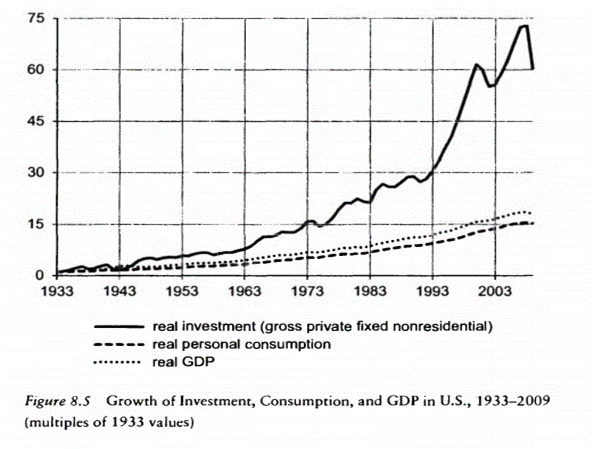
Indeed, as Kliman says, the reproduction schemes provide a model for the so-called “take-off” process in industrialisation as experienced in early 19th century Britain, late 19th century Japan and early 20th century Russia. In each case the immediate result is that the benefits of rising production do not mostly go to the classes that would consume, ie peasants or wage earners, but instead into the profits of capitalists (Britain) or into a state surplus (Soviet Union), where the proceeds are used for further capital formation. So the reproduction schema can be applied to understanding the process of growth in both capitalist and planned economies (‘primitive socialist accumulation’).
China’s growth in investment and consumption
You would expect a fast-growing economy to have faster growth in investment than consumption. But that does not mean consumption will not rise also. On the contrary, as investment delivers more value, consumption can also expand more quickly than in economies with low investment and GDP growth. A good example of this is China’s ‘take-off’. China has had a very high investment to GDP ratio (graph below).
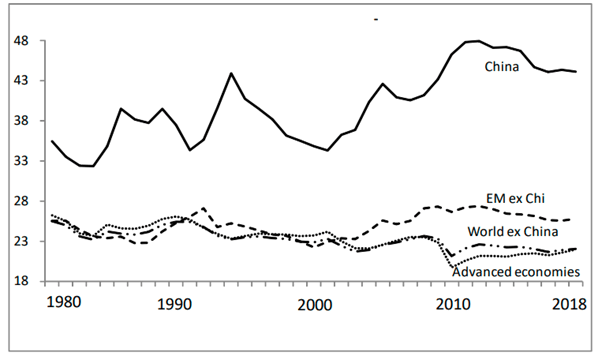
Mainstream economists, especially Keynesians, reckon that this is bad news for workers’ consumption and needs to be reversed. They base their case on China’s supposedly low personal consumption to GDP ratio compared to the advanced capitalist economies. But that’s not really true. If you strip out private health spending from the US consumption ratio to GDP (see graph below) and on the other hand add various social consumption spending (health, education, transport, etc) to China’s personal consumption ratio, the supposed gap to the US and other G7 countries is narrowed considerably.
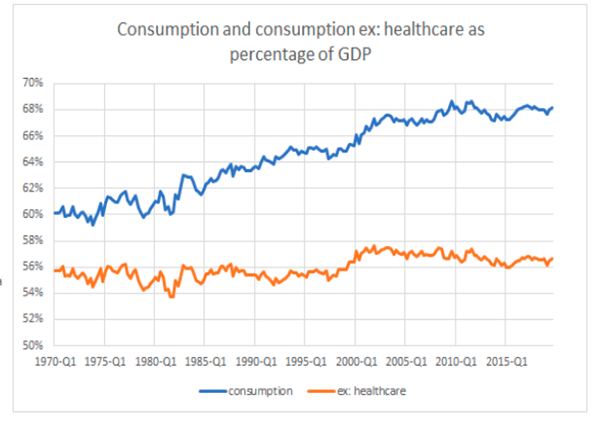
Moreover, contrary to the Keynesian argument, personal consumption growth in China has been way faster than in any advanced capitalist economy in the last ten years. Why? Because investment and GDP growth has been much faster.
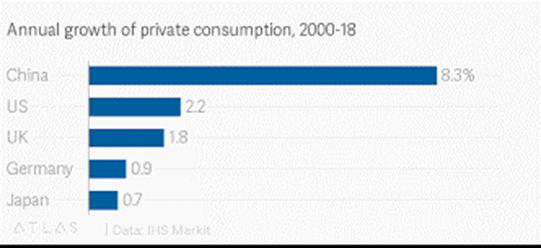
China’s huge ‘imbalance’ of investment in capital goods compared to consumption may have restricted wage growth, but not compared to countries that have not invested and grown as fast. In the 2010s, wage growth in China rose 73%, compared to India at 43%, the US at 11% and the UK at just 3%.
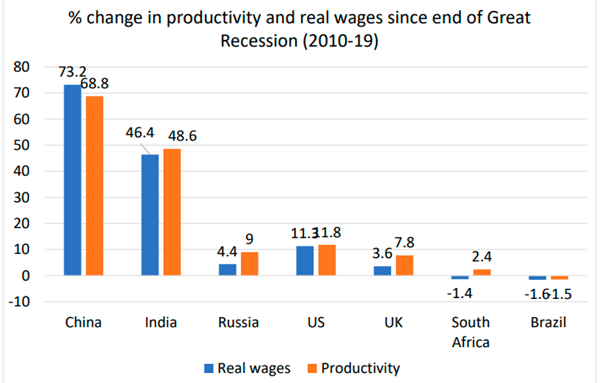
Indeed, even mainstream growth models reach the same conclusion as in Marx’s reproduction schema. In the Keynesian-style Harrod-Domar growth model, full employment and maximum growth potential require that investment in each period be greater than savings in the previous year.
Domar comments that the model shows “that it is not sufficient, in Keynesian terms, that savings of yesterday be invested today, or . . . that investment offset saving. Investment of today must always exceed savings of yesterday.”
The real cause of crises in capitalism
The Keynesian growth model talks of the ‘savings function’; for Marx, savings are profits because workers do not save, so there is a class aspect to his reproduction model. For Marx, the rate of growth of the economy depends on the proportion of surplus value that is accumulated rather than spent on capitalists’ consumption; on the rate of exploitation of labour producing the surplus value and on the organic composition of capital, setting the relative investment of profits into technology or labour. The Keynesian Harrod-Domar model is similar. Here the growth rate depends on the “marginal propensity to save” (in Marxist terms, the amount of profits reinvested) and the productivity of that investment (in Marxist terms, the rate of profit). Most important, in both models it is the previous period’s savings (profits) that sets the level of investment in the next period.
But there is an important difference between the Keynesian growth model and that of Marx. In both models, for growth, investment must outstrip consumption; but for Marx, under capitalism, that investment growth depends on profitability, while in a post-capitalist economy, investment depends on state planning decisions. Keynes makes no such distinction and thus ignores the real cause of crises in capitalism.
From the blog of Michael Roberts. The original, with all charts and hyperlinks, can be found here.

